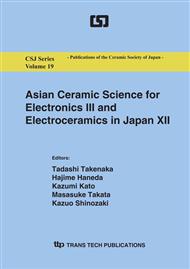[10]
in agreement with d-spacing observed for H2Ti4O9. These results indicated the occurrence of layered product dispersed into the polymeric matrix and, suggesting an in-situ reassembling process upon the membrane preparation procedure, which led to the formation of nanometric scaled TNS packets. CO�CLUSIO�S TNS content is critical in determining morphology, dimensional stability, and conductivity properties of SPEEK/TNS composite membranes, as proven by SEM observations, water uptake measurements, and EIS analysis. Membranes with low content of inorganic additive showed enhanced proton conductivity with respect to pure SPEEK (C0), associated to the improvement in swelling properties. Additionally, XRD analysis indicated the presence of intercalated compounds dispersed in the polymeric matrix, thus suggesting an in-situ reassembling process. In conclusions, encouraging results were obtained even if further improvement of the electrochemical properties may be achieved by appropriate tailoring of all the relevant properties of both components, ionomer polymer and inorganic filler. ACK�OWLEDGME�TS This work has been supported by the Italian Ministry of Foreign Affairs (MAE) under the frame of the Italy-Japan Joint Laboratory on Nanostructured Materials for Environment and Energy. REFERE�CES.
Google Scholar
[1]
Q. Li, R. He, J. O. Jensen, N. J. Bjerrum, Chem. Mater., 15 (2003), p.4896.
Google Scholar
[2]
O. Savadogo, J. Power Sources, 127 (2004), p.135.
Google Scholar
[3]
R. Devanathan, Energy & Environm. Sci. 1 (2008), p.119.
Google Scholar
[4]
M. Watanabe, H. Uchida, Y. Seki, M. Emori, P. Stonehart, J. Electrochem Soc., 143 (1996), p.3847.
Google Scholar
[5]
S. Licoccia, E. Traversa, J. Power Sources, 159 (2006), p.12.
Google Scholar
[6]
H. -C. Kuan, C. -S. Wu, C. -Y. Chen, Z. -Z. Yu, A. Dasari, Y. -W. Mai, Electrochem. Solid State Lett., 9 (2006), p. A76.
Google Scholar
[7]
D. R. Paul, L. M. Robenson, Polymer, 49 (2008), p.3187.
Google Scholar
[8]
M. L. Di Vona, D. Marani, A. D'Epifanio, E. Traversa, M. Trombetta, S. Licoccia, Polymer, 46, (2005), p.1754.
DOI: 10.1016/j.polymer.2004.12.033
Google Scholar
[9]
S. M. J. Zaidi, S. D. Mikhailenko, G. P. Robertson, M. D. Guiver, and S. Kaliaguine, J. Membr. Sci., 173 (2000), p.17.
Google Scholar
[10]
S. Suzuki, M. Miyayama, J. Phys Chem. B, 110 (2006), p.4731.
Google Scholar
[11]
A. Saccà, A. Carbone, E. Passalacqua, A. D'Epifanio, S. Licoccia, E. Traversa, E. Sala, F. Traini, R. Ornelas, J. Power Sources, 152 (2005), p.16. e-mail: debora. marani@uniroma2. it Fax: +39-06-7259-4328.
DOI: 10.1016/j.jpowsour.2004.12.053
Google Scholar


